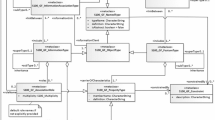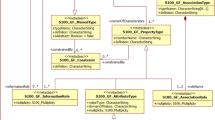Abstract
In the maritime field, e-navigation, a new-paradigm information service framework that provides proper, accurate and timely information related to various marine activities at sea, has been widely discussed. For consistent exchange, sharing, and use of data among e-navigation services, the S-100 standard of the International Hydrographic Organization was adopted as the Common Maritime Data Structure. To provide proper information in the form of e-navigation services for various activities at sea, it is necessary to integrated, at the semantic level, S-100-based data that exists in several domains and is distributed both onboard and ashore. Whereas S-100, as the common data model, resolves the issue of syntactic interoperability among domains, it does not provide for semantic interoperability. In this paper, we introduce for the purposes of effective e-navigation, a multi-domain data utilization structure based on a marine knowledge base for support of the semantic representation of S-100-compliant data and their semantic interrelationships. The multiple-domain data utilization structure enables e-navigation services to access multiple-domain data and to find the e-navigation services best supporting their marine activities.




Similar content being viewed by others
References
Patraiko, D.: Introducing the e-navigation revolution. Seaways. http://www.nautinst.org/download.cfm?docid=94103369-7699-4CEMQFjAD (2007). Accessed 30 Oct 2013
Alexander, L., Ward, C.R.: Hydrographic products/services as a fundamental omponent of the e-navigation concept of operation. In: Canadian Hydrographic Conference (2010)
Malyankar, R., Hauge, J.J.: The IHO S-100 Standard and e-Navigation Information. IALA e-Nav10/INF/7 (2011)
Bergmann, M.: Hydrographic data as the basis for integrated e-navigation data streams. Mar. Navig. Saf. Sea Transp. 63, 1 (2013)
Ward, R., Alexander, L., Greenslade, B.: IHO S-100: the new IHO hydrographic geospatial standard for marine data and information. Int. Hydrogr. Rev. 1, 44–55 (2009)
IHO 2015. S-100—universal hydrographic data model. IHO. http://iho.int/iho_pubs/standard/S-100/S-100_Version_2.0.0.zip (2015). Accessed 20 Oct 2015
IMO NCSR 1/INF.21 Development of an e-navigation strategy implementation plan—Overview of the Maritime Cloud concept. https://docs.imo.org/Shared/Download.aspx?did=86663 (2014). Accessed 5 Nov 2015
Park, D., Park, J., Kwon, D., Kwon, H.C., Park, S.: Design of data structure for system ENC kernel. In: IEEE International Conference on IT Convergence and Security (ICITCS), pp. 1–3 (2013)
Neal, G.M., Simon, E.: Hydrographic data management using GIS technologies. http://dusk.geo.orst.edu/djl/arcgis/docs/hydro-datamgmt.pdf (2014). Accessed 17 Feb 2014
Park, D., Park, S.: E-navigation-supporting data management system for variant S-100-based data. In: Multimedia Tools and Applications, pp. 1–16 (2014)
Weintrit, A.: Telematic Approach to e-Navigation Architecture. Transport Systems Telematics. Springer, Berlin (2010)
Patraiko, D.: The development of e-navigation, advances in marine navigation and safety of sea transportation. In: TransNav (2007)
Patraiko, D., Wake, P., Weintrit, A., Guan, K., Shi, C., Wu, S., et al.: e-Navigation and the human element. Mar. Navig. Saf. Sea Transp. 4, 29 (2009)
Weintrit, A., Wawruch, R., Specht, C., Gucma, L., Pietrzykowski, Z.: Polish approach to e-Navigation concept. Coordinates 3(6), 15–22 (2007)
Berners-Lee, J., Hendler, J., Lassila, O.: The semantic web. Sci. Am. 184(5), 34–43 (2001)
Gruber, T.R.: Towards principles for the design of ontologies used for knowledge sharing. Int. J. Hum. Comput. Stud. 43(5–6), 907–928 (1995)
Guarino, N.: Formal ontology and information system. In: Proceedings of FOIS’98, pp. 3–15 (1998)
ISO TC/211 N 2705 report from stage 0 project 19150 geographic information—ontology (2009)
Park, S.: S-100 metadata conversion design of the OWL-based ontology. J. Korean Inst. Inform. Commun. Eng. 15(11), 2333–2339 (2011)
Bernad, L., Einspanier, U., Haubrock, S., Hubner, S., Klien, E., Kuhn, W., Lessing, R., Lutz, M., Visser, U.: Geotechnologien science report “Ontology-based Discovery and Retrieval of Geographic Information in Spatial Data Infrastructures,” report no. 4. http://www.delphi-imm.de/meanings/index_eng.html (2004)
Klien, E., Lutz, M., Einspanier, U., Hubner, S.: An architecture for ontology-based discovery and retrieval of geographic information. In: Proceedings of the 7th Conference on Geographic Information Science (AGILE 2004), pp. 179–188 (2004)
Parekh, V., Gwo, J.-P., Finn, T.: Ontology based semantic metadata for geoscience data. In: International Conference of Information and Knowledge Engineering (2004)
Zhan, Q., Li, D., Zhang, X., Xia, Y.: Ontology-based geographic information semantic metadata integration. In: Proceeding of SPIE, vol. 7146 (2008)
Zhan, Q., Zhang, X., Li, D.: Ontology-based semantic description model for discovery and retrieval of geo-spatial information. Int. Arch. Photogr. Remote Sens. Spatial Inform. Sci. 37, Part B4 (2008)
Wariyapola, P.C.H., Abrams, S.L., Robinson, A.R., Streitlien, K., Patrikalakis, N.M., Elisseeff, P., Schmidt, H.: Ontology and metadata creation for the poseidon distributed coastal zone management system. In: Proceedings of the IEEE Forum on ADL ’99, pp. 180–189 (1999)
Park, D., Kwon, H.-C., Park, S.: Ontology for semantic representation of marine metadata, In: Proceedings of the 7th International Conference on Ubiquitous Information Management and Communication, Article No. 66 (2013)
Acknowledgments
This work was supported by the IT R&D program of MKE/KEIT [10041790, Development of Advanced Ship Navigation Supporting System based on the Oncoming International Marine Data Standard] and was partially supported by the Brain Busan 21 Project in 2015.
Author information
Authors and Affiliations
Corresponding author
Rights and permissions
About this article
Cite this article
Park, D., Park, S. Multiple-domain marine data utilization structure for e-navigation. Cluster Comput 19, 301–308 (2016). https://doi.org/10.1007/s10586-015-0521-1
Received:
Revised:
Accepted:
Published:
Issue Date:
DOI: https://doi.org/10.1007/s10586-015-0521-1




